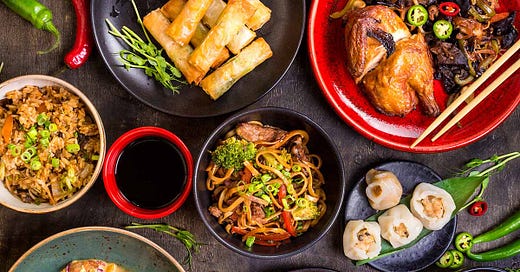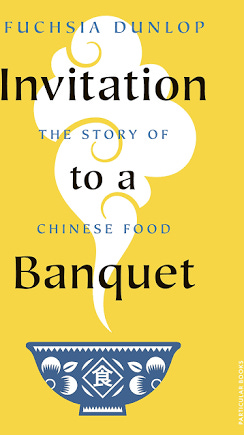Food and identity in China
On grain, the spirit world, corrupt officials, vegetarianism and beef
Dear Global Jigsaw,
As mentioned in a previous post on China’s written language, another deep source of continuity in the erstwhile Middle Kingdom is food. Language and gastronomy, rather than religion, architecture, or climate, are the key to the resilience of China’s sense of self through constant political upheavals.
Food is at the very core of Chinese national identity. It is as important symbolically, as it is as nourishment, standing in for everything from medicine and worship to supplication and bribes. No one writes better about Chinese food, for a foreign audience, than Fuschia Dunlop. I have several of her recipe books, but her latest work, Invitation to a Banquet, is not a cookbook. Rather, it’s a deep dive into gastronomic sociology. If you are interested in understanding China, this is a better place to start than many conventional histories.
Dunlop expands on the insight that for the Chinese, cooking – or using fire to transform raw food- was what separated their “civilized” selves from the nomadic barbarians, who “drank blood and ate feathers” (ru mao yin xue), on their borders. But fire wasn’t the only element of this culinary Great Wall that drew a conceptual line between the Han Chinese and the Mongol meat-eaters, who were a constant and menacing presence on the frontier doors. There was also grain.
Settled agriculture and the cultivation of grain, in particular rice, is what makes the Chinese themselves in an atavistic sense. The country consumes more rice than any other nation, and the centrality of the grain to the civilization is apparent in the way it permeates idiom and language.
The standard greeting in China, the equivalent of for example, “How’s it going?” is “Chi fan le ma?” or “have you eaten your rice yet?” While the word, “fan” technically refers to any type of grain, its usually used to equate rice. Dunlop points out how the term for a restaurant in Chinese is fan guan, or a place that serves rice. To cook, is to zuofan or ‘make rice,’ while a beggar is someone who yao fan, ‘begs for rice.’ In Maoist times, a job at a state owned enterprise, which provided a stable living and from which it was almost impossible to be fired, was referred to as tie fan wan, the iron rice bowl.
Bowls of rice are also part of the tempting repast that the Chinese customarily offer to family ancestors. The “qi” or essence of these mortal culinary treats is thought to waft up and nourish the spirits of the beloved deceased. Food has traditionally formed the bridge between the world of the living and the spiritual realm.
Dunlop describes how during the Zhou Dynasty (1046 BC – 256 BC) more than 2000 people were engaged in the “preparation of food and wine for both the spirits and mortals of the imperial household.” These included all manner of experts from turtle specialists to pickle authorities. Dozens of personnel were responsible just for ice and salt.
Food has also been used to feed and appease the spirits of various Taoists and Buddhist deities, as a way of asking for boons. This ancient practice has its modern avatar in the wining and dining that officials in contemporary China often expect in lieu of monetary bribes. A banquet of shark’s fin soup and abalone, expensive boxes of mooncakes, or bottles of Rémy Martin are the preferred way of buttering up influential people. When President Xi Jinping came to power in 2013, amongst his first moves was to launch an anti-corruption campaign, the centerpiece of which was a ban on lavish banquets for party cadres. Graft and gluttony have long gone hand-in-hand in China.
But although communist party apparatchiks have had to downgrade their gastronomical adventures to more modest levels of consumption in the Xi-era, food remains the most important social lubricant. Paying for someone’s meal, binds them to you and also confers a sense of power on the inviting party. Which explains the many scenes at restaurants that I witnessed, when I lived in Beijing in the early 2000s, where diners warring to pay the bill actually ended in light fisticuffs.
When talking about China’s gastronomy, wet-markets and exotic animals are a subject that the COVID pandemic has made impossible to ignore. The origin of the SARS virus in 2003 was linked to the consumption of wild civet cats. And although the COVID virus’ origins remain shrouded in mystery it has been linked to the eating of bats and pangolins.
Dunlop explains that obscure parts of rare and exotic creatures such as bear paws and shark fins, have formed part of the diet of a rarified elite of Chinese gourmets for millennia. These foods were prized for a number of reasons, ranging from their scarcity and expense, which gave them prestige, to their putative medicinal qualities. When I was pregnant with my first child in Beijing for instance, my Chinese friends all recommended bird’s nest soup – made from the saliva of southeast Asian swiftlets- as a tonic.
Dunlop does not condone the more destructive side of such culinary adventurism, which can be both cruel and ecologically dangerous. However, she also has little patience with the standard foreign horror at Chinese openness to a diversity of food sources, which she, rightly, accuses of being tinged with racism.
China’s is a culture in which eating audaciously is “understood as a joyous way of inhabiting and experiencing the world.” This delight in a multiplicity of food is expressed in a poem called the “Great Summons,” written 2,300-odd years ago, by the poet and aristocrat Qu Yuan. It is designed to tempt a departed soul back to the land of the living:
The five kinds of grain are heaped six ells high, and the corn of
zizania.
Cauldrons seethe to their brims, wafting a fragrance of well-
blended flavours;
Plump orioles, pigeons and geese, flavoured with broth of jackal’s
meat.
O soul, come back! Indulge your appetite!
Fresh turtle, succulent chicken, dressed in the sauce of Chu;
Pickled pork, dog cooked in bitter herbs and ginger-flavoured
mince,
Roast crane next is served, steamed duck and boiled quails,
Fried bream, stewed magpies and green goose, broiled.
O soul, come back! Choice things are spread before you.
In China, amazing dinner guests with out of the ordinary culinary dazzle – think yak penis which used to cost around USD200 per, erm, serving at a restaurant in Beijing that specialised in animal penises - is part of the pleasure of elite gastronomy. Dunlop compares it to the “wow factor” that rare vintage wines provide in the West.
One can imagine the dilemma that arose when China’s customary all-encompassing gastro-propensity, collided with the arrival of meat-restricting Buddhism from India, in about the first century AD. Vegetarianism, in the past, was only practiced for reasons of poverty. Now, it gradually transformed into a religious lifestyle choice for a section of society, in particular monks. The strictures against eating meat in Buddhism were a way of cultivating compassion and avoiding bad karma, but wholly countercultural. Consider the fact that in Chinese the word for home, jia (家)is a character that depicts a pig under a roof. Home is where the soon-to-be-eaten pig is.
And so it was, that the Chinese began experimenting with mock meats, made out of plant sources like tofu and bamboo shoots, more than 1000 years before the contemporary trend of vegan burgers and “impossible meats.” In India, where vegetarianism stems from an abhorrence of the killing of animals, the Chinese “vegetarian” restaurant that lists only “trompe-l’oeil” meat dishes on its menu, is confounding.
But in China, the default social assumption is that meat is desirable and giving it up a sacrifice. There is a famous Fujianese banquet dish, for example, that is called fotiaoqiang or Buddha Jumps Over the Wall. This is a stew of marine exotica, including sea cucumbers, abalone and shark fin, whose fragrance is ostensibly so irresistible that it makes even the most devout of Buddhists quit their vows.
Hence, the propensity of vegetarian eateries in China to offer “pork belly” made of winter melon or “shark’s fin” of mung bean noodles. It allows Buddhists, and other vegetarians, to fit in with the social convention that a significant meal must include meat.
Dunlop’s book also points out that the default meaning of “meat” in China was/is pork, rather than beef, unlike in many parts of Europe or the Americas. In fact, at various points in history Chinese rulers issued edicts banning the consumption of beef. These bans were for practical, rather than religious, reasons because oxen were considered an invaluable assistant in the fields. The idea was that they deserved protection and gratitude in their old age for having worked so hard to help farmers. But even during the periods when cattle-slaughter was banned by imperial edict, Chinese Muslims, were exempt from the law.
Writing in 1882, J.L. Nevius, an American missionary who had spent much of his adult life in China, described in fairly absolute terms a revulsion for beef: “Beef is never exposed for sale in the Chinese markets.…There is a strong and almost universal prejudice against eating beef...” For many at the time, eating a cow would have been seen as akin to eating the family pet. Similar to the contemporary horror in the West at eating dogs.
It was only in the 20th century that beef, gradually became more popular. Western missionaries and evangelists had a role to play in this change. Many of their writings spread the notion that beef was central to a nutritious diet. For example, the 19th century English Anglican missionary John Fryer ran a serialized translation of the early health and nutrition manual “The Chemistry of Common Life,” informing readers that “beef and bread are the staples of English life.”
Dunlop concludes with a quote from the writer Lin Yutang, who wrote in his 1935 classic, “My Country and My People: “if there is anything we (the Chinese) are serious about, it is neither religion, nor learning, but food. We openly acclaim eating as one of the few joys in this human life.”
Food, in general, is both a biological necessity and fundamental part of the joy of being alive. It can be an anchor amidst the turbulence of life (think COVID-19 lockdowns and the cooking-consolation so many of us turned to), a refuge from personal disillusionment and in China, especially, a place of freedom in the face of political oppression.
xxx
Ihave become so hungry writing this, that I will leave you, dear reader, to rummage in the kitchen. Before I go, an appeal for you to become a paid subscriber. Its easy, and affordable. Just click here and follow the instructions:
I would also love your feedback on this post and any other you may want to discuss further:
Finally, do share with others :-)
I am sending this week’s post out early because of travels later in the week. Next newsletter will be out towards the end of next week.
Stay well,
Un abrazo,
Pallavi
PS: A version of this article appeared in Open Magazine here.






Loved this piece Pallavi. Power to you
What a delightful set of insights! Thank you for sharing this trans-cultural gem…my sociologist family and friends will love it!